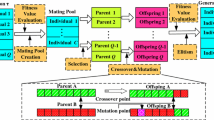Abstract
In this paper, the multiuser linear cooperative spectrum sensing optimization problem in cognitive radio system where the primary user (PU) and cognitive radio (CR) employ multiple antennas is investigated. By optimizing the different weights assigned on the statistic of each CR given a targeted probability of false alarm, the cooperative spectrum sensing optimization focuses on maximizing the probability of detection. Statistical characteristics of parameters in cooperative spectrum sensing for the PU with a single antenna and the CR with multiple antennas (SPMC) system, the PU with multiple antennas and the CR with a single antenna (MPSC) system, both the PU and the CR with multiple antennas (MPMC) system as well as the PU with Alamouti coding system have been investigated. Due to the non-convex characteristic of the cooperative spectrum sensing problem, an efficient parallel artificial bee colony (PABC) method motivated by the intelligent foraging behavior of a honeybee colony is introduced to address the problem without approximations and convexity constraints. Furthermore, classical benchmark functions are presented to validate the searching ability of the proposed algorithm. Simulation results showed that the PABC shows a superior ability when applied in both the typical test functions and the cooperative spectrum sensing scenario. Also, the reliability of spectrum sensing can be significantly promoted with the use of multiple antennas and Alamouti coding.







Similar content being viewed by others
References
I.F. Akyildiz, W.-Y. Lee, M.C. Vuran, S. Mohantly, Spectrum sensing for cognitive radio. Proc. IEEE 97(5), 849–877 (2009)
B. Chen, P.K. Willett, On the optimality of likelihood ratio test for local sensor decision rules in the presence of non-ideal channels. IEEE Trans. Inf. Theory 51, 693–699 (2005)
G. Ganesan, Y. Li, Cooperative spectrum sensing in cognitive radio, part II: multiuser networks. IEEE Trans. Wirel. Commun. 6(6), 2214–2222 (2007)
A. Ghasemi, E.S. Sousa, Collaborative spectrum sensing for opportunistic access in fading environments, in Proceedings of IEEE International Symposium on New Frontiers in Dynamic Spectrum Access Networks (2005), pp. 131–136
D. Karaboga, B. Basturk, A powerful and efficient algorithm for numerical function optimization: artificial bee colony (ABC) algorithm. J. Glob. Optim. 39, 459–471 (2007)
D. Karaboga, An idea based on honey bee swarm for numerical optimization, Technical Report-TR06, Erciyes University, Computer Engineering Department (2005)
W. Lee, D.H. Cho, Enhanced spectrum sensing scheme in cognitive radio systems with MIMO antennae. IEEE Trans. Veh. Technol. 60(3), 1072–1085 (2011)
M. Lin, A.P. Vinod, A low complexity high resolution cooperative spectrum-sensing scheme for cognitive radios. Circuits Syst. Signal Process. 31(3), 1127–1145 (2012)
J. Ma, G. Zhao, Y. Li, Soft combination and detection for cooperative spectrum sensing in cognitive radio networks. IEEE Trans. Wirel. Commun. 7(11), 4502–4507 (2008)
S.M. Mishra, A. Sahai, R.W. Brodersen, Cooperative sensing among cognitive radios. Proc. IEEE Int. Conf. Commun. 4, 1658–1663 (2006)
E. Peh, Y.C. Liang, Optimization for cooperative sensing in cognitive radio networks, in Proceedings of IEEE Wireless Communications and Networking Conference (2007), pp. 27–32
Z. Quan, S. Cui, A.H. Sayed, Optimal linear cooperation for spectrum sensing in cognitive radio network. IEEE J. Sel. Top. Signal Process. 2(1), 28–40 (2008)
Z. Quan, W.-K. Ma, S. Cui, A.H. Sayed, Optimal linear fusion for distributed detection via semidefinite programming. IEEE Trans. Signal Process. 58(4), 2431–2436 (2010)
M. Sanna, M. Murroni, Optimization of non-convex multiband cooperative sensing with genetic algorithms. IEEE J. Sel. Top. Signal Process. 5(1), 87–96 (2011)
K.C. Sriharipriya, K. Baskaran, Collaborative spectrum sensing of cognitive radio networks with simple and effective fusion scheme. Circuits Syst. Signal Process. 33(9), 2851–2865 (2014)
A. Tabesh, A. Taherpour, Z. Pourgharehkhan, Multiple antenna spectrum sensing using statistical a-priori information in cognitive radios. IET Signal Process. 7(1), 59–70 (2013)
J. Unnikrishnan, V.V. Veeravalli, Cooperative sensing for primary detection in cognitive radio. IEEE J. Sel. Top. Signal Process. 2(1), 18–27 (2008)
A.P. Vinod, E.M.-K. Lai, P.K. Meher, J. Palicot, S. Mirabbasi, Guest editorial: special issue on embedded signal processing circuits and systems for cognitive radio-based wireless communication devices. Circuits Syst. Signal Process. 30(4), 683–688 (2011)
S. Zheng, C. Lou, X. Yang, Cooperative spectrum sensing using particle swarm optimisation. Electron. Lett. 46(22), 1072–1085 (2008)
Y.M. Zhou, Z. Zhou, S.B. Zhang, An improved spectrum sensing method: energy-autocorrelation-based detection technology. Circuits Syst. Signal Process. 32(1), 273–282 (2013)
Acknowledgments
The authors would like to thank support from the 111 Project (B08038), the National Science Foundation of China under Grants (61101069, 61201135, 61201134) and the Fundamental Research Funds for the Central Universities (7214569601), the National Key Project of New Generation Broad Band Wireless Communication (2012ZX03001027-001).
Author information
Authors and Affiliations
Corresponding author
Rights and permissions
About this article
Cite this article
Hei, Y., Li, W., Fu, W. et al. Efficient Parallel Artificial Bee Colony Algorithm for Cooperative Spectrum Sensing Optimization. Circuits Syst Signal Process 34, 3611–3629 (2015). https://doi.org/10.1007/s00034-015-0028-2
Received:
Revised:
Accepted:
Published:
Issue Date:
DOI: https://doi.org/10.1007/s00034-015-0028-2




